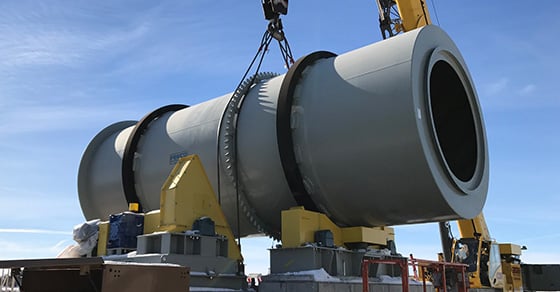Coating drums are increasingly being employed in production settings to improve the performance, handling qualities, and appearance of products ranging from fertilizers to roofing granules.
As the industry’s leading custom coating drum manufacturer, we’re answering the most frequently asked questions (FAQs) we receive around these diverse machines.
What materials can a coating drum process?
Coating drums can handle any type of bulk solid, so long as it is flowable. This lends them to a wide range of materials, including specialty chemicals, catalysts, adsorbents, fertilizers and soil amendments, and more.
How does a coating drum work?
Similar to other rotary equipment, a coating drum works by tumbling material in a rotating drum. The coating drum is fitted with a spray system that distributes the coating over the material bed. As the drum rotates, granule-to-granule contact distributes the coating throughout the material bed, ensuring all material is uniformly coated.
How is the coating distributed in the drum?
Coating drums use a specially designed spray system that atomizes the coating into a spray over the material bed. The tumbling motion then distributes the coating throughout the bed through contact between granules.
The spray system is a very custom aspect of the coating drum, often requiring testing in a facility such as the FEECO Innovation Center to establish design criteria.
How is a coating drum different from coating with a conveyor?
Coating drums offer a few key advantages compared to coating material on a conveyor. Most importantly, they provide much more uniform results due to the mixing action that occurs in the tumbling drum. In contrast, on a conveyor, material is stationary on the belt, so only the outermost layer receives the coating. Overspray can also be a problem when coating on a conveyor. For more information, see our article, Improving the Fertilizer Coating Process With a Coating Drum.
Can coating drums handle powder coating agents, or do they have to be liquid?
Coating drums are capable of distributing both powder and liquid coatings.
Do I need a dryer after coating?
No. Unless the coating has a high moisture content that would require moisture removal, no drying is necessary.
Are coating drums batch or continuous?
While coating drums may be available in either configuration, FEECO engineers only continuous coating drums suitable for high-capacity production settings such as fertilizer granulation plants.
What is the retention time for a coating drum?
The retention time, or residence time, is based on how long it takes to meet product quality specifications and as such, varies significantly from one process to the next, ranging anywhere from 30 seconds to over one hour.
How do I know if a coating drum is right for my process?
Coating drums are suitable for coating any flowable material and offer significant advantage over coating with a conveyor belt. Specific questions or challenges, as well as the establishment of key process criteria, can be addressed through process development testing.
What capacities can coating drums handle?
Coating drums can handle anywhere from a few hundred pounds per hour to hundreds of tons per hour.
What are the typical wear items?
Wear items are similar to other rotary equipment: seals, trunnion wheels/rollers, tires, thrust rollers and internals. As with any other type of rotary drum, it is important to maintain proper drum alignment and address any wear on tires and trunnions through grinding. FEECO also recommends the OEM perform an annual inspection (in addition to regular inspections by plant personnel as part of a preventive maintenance program).
How do I prevent caking and buildup in the coating drum?
The prevention of caking and buildup should always first be addressed through the equipment’s design. Engineers should limit places where material could catch and accumulate, as well as carefully choose materials of construction.
A drum liner can also help to prevent buildup, as well as protect the drum shell from corrosion and abrasion.
What data is needed to design a coating drum?
Engineers require a number of data points to design a coating drum. Most importantly:
- Raw material feed rate
- Bulk density
- Type of coating
- Coating feed rate
- Coating properties (physical and chemical)
- Desired retention time (can be established through testing)
- Desired material of construction
- Required capacity
Can coating drums be automated?
Yes, coating drums can be automated with a controls package that automates feed rate and coating addition, as well assists in start-up and shutdown of the unit.
Do coating drums require a recycle circuit?
No, since coating is generally employed as a finishing process, no size separation or reduction is necessary after processing.
What other equipment is necessary to support a coating drum?
Coating drums require feeding equipment for the raw material, as well as pumping equipment for the coating (in the case of a liquid). In settings where fugitive dust is possible, an exhaust gas handling system may be necessary. FEECO also recommends the incorporation of a variable frequency drive or VFD to give operators greater control over drum speed and responding to process fluctuations.
Conclusion
Coating drums offer producers an effective tool to improve product appearance, performance, and handling characteristics. FEECO is the industry’s preferred coating drum supplier, providing producers with reliable coating drums built for performance and longevity. For more information on our coating drums or testing capabilities, contact us today!



